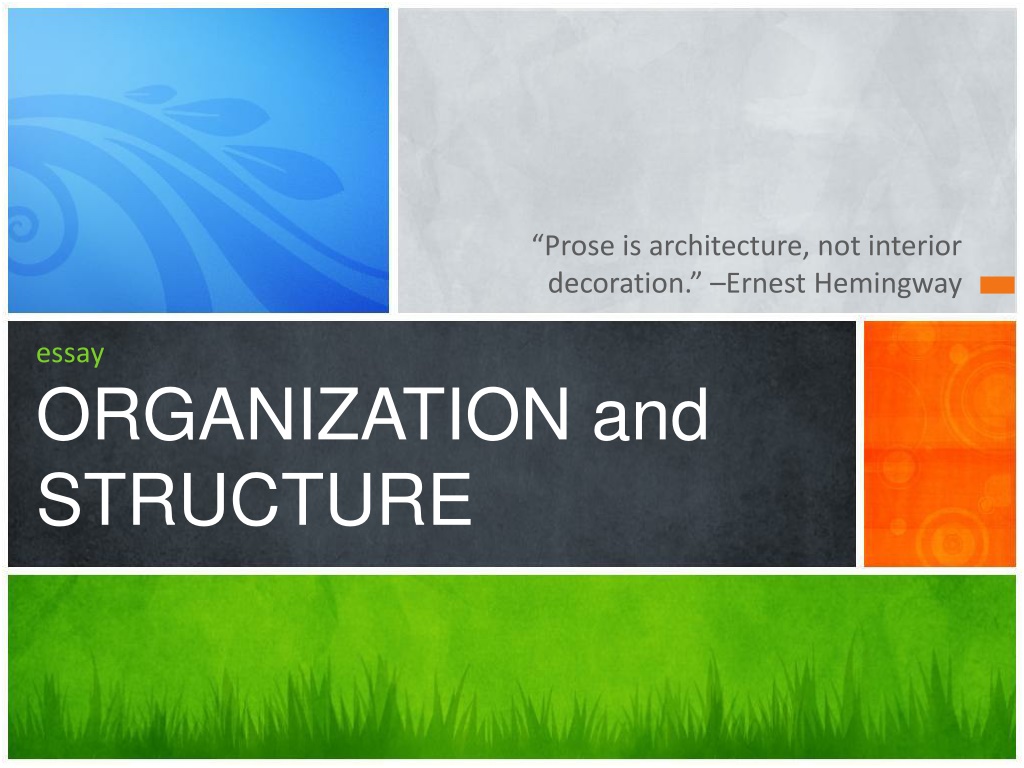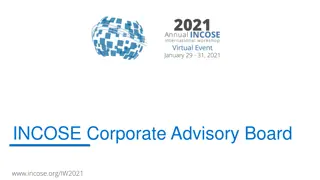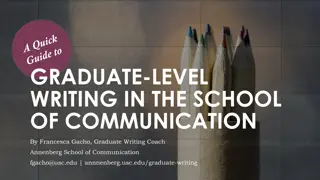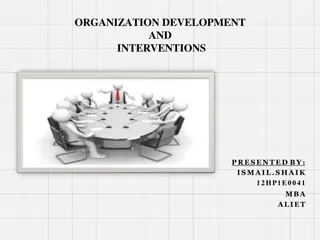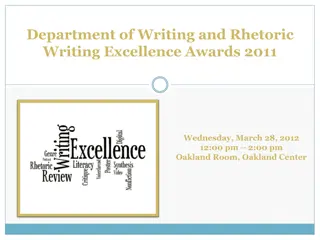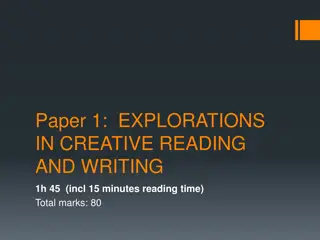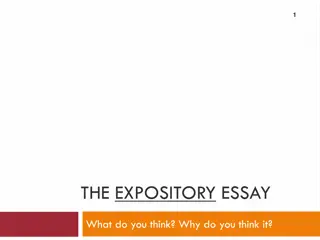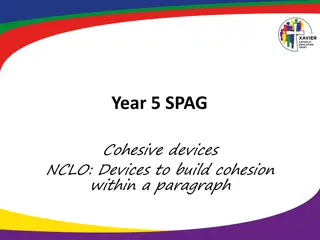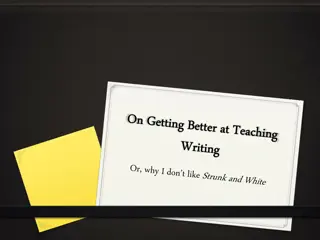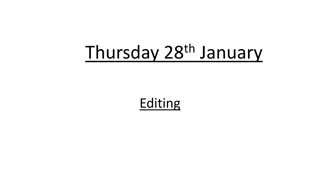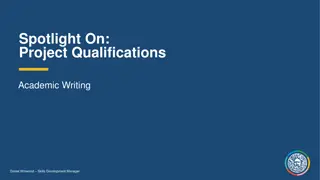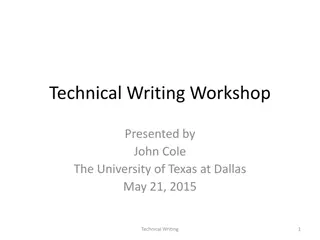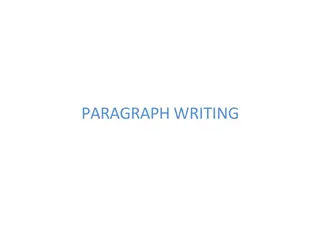Understanding the Organization and Structure of Writing
Explore the fundamental aspects of structuring writing including the importance of introductions, effective opening sentences, and the basic essay structure with a focus on capturing the reader's attention and conveying the main thesis effectively. Discover how to build a cohesive structure that enhances the overall impact of your writing, inspired by Ernest Hemingway's view that prose is akin to architecture.
Download Presentation

Please find below an Image/Link to download the presentation.
The content on the website is provided AS IS for your information and personal use only. It may not be sold, licensed, or shared on other websites without obtaining consent from the author. Download presentation by click this link. If you encounter any issues during the download, it is possible that the publisher has removed the file from their server.
E N D
Presentation Transcript
Prose is architecture, not interior decoration. Ernest Hemingway essay ORGANIZATION and STRUCTURE
Building a Structure The structure, or form, that we give a piece of writing depends on the subject and the audience (recall the rhetorical triangle). Ex. Writing a resume
The Basic Essay Structure Introduction Conclusion Body Paragraphs The common thread that links all of these parts together is your thesis.
Writing Introductions What s the point?
Why are introductions important? Introductions are the bridge that transports your reader into the your essay, your frame of mind. Your introduction is your first impression.
What are the parts of an introduction? Grab the reader s attention with a thought-provoking opening line. Give relevant background information (explain the context of your argument, define your terms). Present a road map of your paper by introducing the parts of your argument. As you do this, move from broad statements to specific statements. State your thesis.
Opening Sentences that Put Readers to Sleep The Webster s Dictionary introduction Ex. Webster's dictionary defines marriage as a social union or legal contract between people that creates kinship. The Dawn of Man introduction Ex. Since the dawn of man, people have fallen in love and joined together in marriage. The Placeholder introduction Ex. Marriage has been an important institution in American culture throughout history. There are many different kinds of marriage. Each involves different traditions for different groups of people.
Opening Sentences that Grab a Reader s Attention An Intriguing Example Ex. Many Americans remember the infamous Casey Anthony trial, which took place after a two-year-old girl was reported missing from her home in Florida. A Thought-Provoking Question Ex. Given that recent studies suggest that two women can raise children more effectively than a man and a woman, why do so many people resist the idea of homosexual adoption? A Puzzling Scenario Ex. Viewers cannot hear what Bill Murray whispers to Scarlett Johansson at the end of Lost in Translation, yet the film s underlying meaning centers around that very scene. A Vivid Anecdote Ex. Last year, a man in Springfield came home from his job at the local grocery to discover his wife lying in a pool of blood on the floor.
How do you write introductions? Strategies for Writing an Introduction Write the introduction last. Any ideas, strategies, or suggestions? Write a tentative introduction and then change it later.
Body Paragraphs Developing ideas, clarifying your points, and illustrating concepts
The MEAL Plan: Introducing Evidence Main idea (topic sentence, promise to the reader) Evidence (quotations, statistics, specific details) Analysis (what the evidence shows) Link back to your thesis ( Consequently, Therefore, This supports the idea that )
1. Main Idea/Topic Sentence Transitions from previous paragraph shows the connection, or relationship, between the two States the overall subject of the paragraph Makes a promise to the reader Do we always see topic sentences in writing?
2. Evidence Dialogue or quotations (entire lines, parts of lines, single words) Ex. The author of the article, Smith, attempts to incite fear in his readers when he writes, Unless we act now, our children will suffer the consequences of this decision. Description Ex. Bush uses short sentences, allowing the reader to process this information at a quick pace.
3. Analysis What does the evidence mean or show? Everyone notices different parts of the quote, so explain and elaborate on which parts of the quote are relevant to your argument. Ex. In Cather in the Rye, Holden Caulfield quips, All morons hate it when you call them a moron. This comment exemplifies his sarcastic tone.
4. Link Back To Thesis Show how that paragraph, and the claims or evidence within that paragraph, supports your main argument.
Writing a Conclusion Transitioning your reader back into their lives and leaving a lasting impression
Strategies to Avoid Restating your thesis or main points Introducing new examples or pieces of evidence
Strategies for Writing Conclusions Play the so what game. Make your readers feel glad that they read your paper. Give them a gift that they can use in the future. Re-consider the terms or background information that you used in the introduction, and show how your paper has contributed to those issues. Pull your ideas together. Provide further questions, conclusions, results, solutions, or a course of action. Pay special attention to the last few lines.
Words that Indicate Relationships between Ideas To show place - above, below, here, there, etc. To show time - after, before, currently, during, earlier, later, etc. To give an example - for example, for instance, etc. To show addition - additionally, also, and, furthermore, moreover, equally important, etc. To show similarity - also, likewise, in the same way, similarly, etc. To show an exception - but, however, nevertheless, on the other hand, on the contrary, yet, etc. To show a sequence - first, second, third, next, then, etc. To emphasize - indeed, in fact, of course, etc. To show cause and effect - accordingly, consequently, therefore, thus, etc. To conclude or repeat - finally, in conclusion, on the whole, in the end, etc.
Blocking (or chunking), outlining, clustering, listing Organizing your Ideas with Prewriting Strategies
Questions for Organizing your Ideas How many blocks/clusters/headings of material will I need? What information and ideas go into each one? What is the best order for them? What is each block/cluster/heading supposed to do? That is, what does each block tell, show, explain, argue, demonstrate, persuade, etc.? How much space do I want each block to take up on the page? That is, how many paragraphs will I need in order to write about each block?
Benefits of Organizing your Ideas through Prewriting: Readers need manageable chunks of information to process at a time. Organizing your ideas helps you consciously lead the reader through your paper (recall the importance of metacognition).
